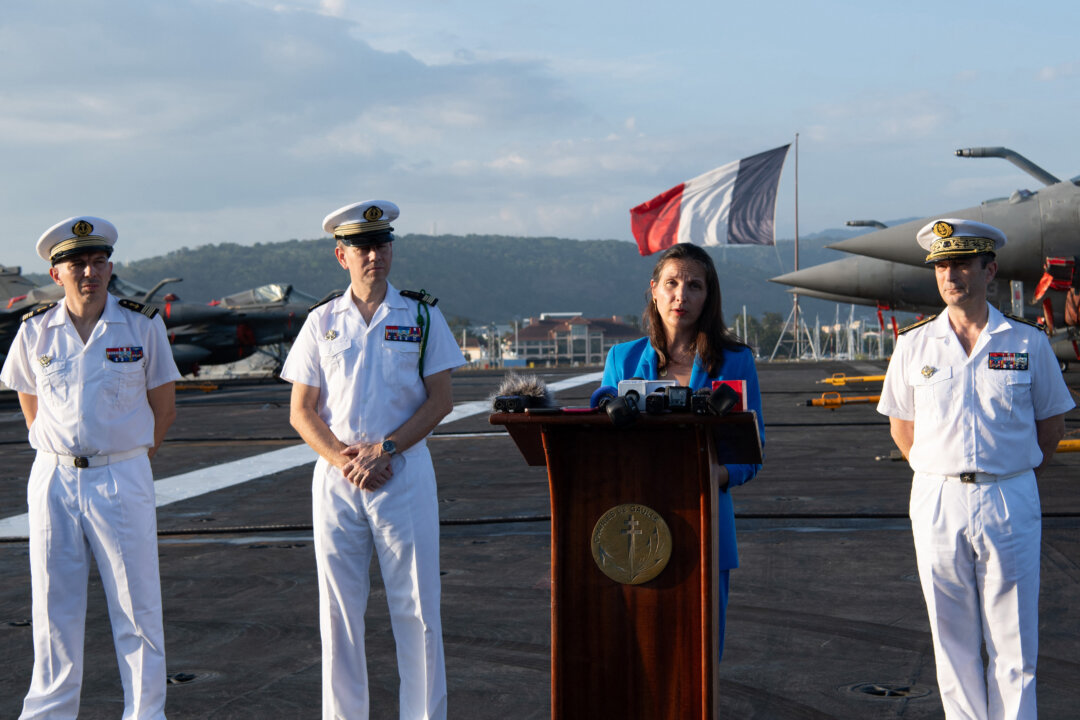‘We aim to deepen our cooperation with regional partners,’ French Ambassador to Manila Marie Fontanel said.
France’s carrier strike group was in the Philippines on Feb. 23 after holding exercises with Philippine forces in the disputed South China Sea, amid rising tension in the region as the Chinese regime has become increasingly aggressive toward its neighbors.
The French strike group, led by nuclear-powered aircraft carrier Charles de Gaulle, docked on Feb. 21 at Subic Bay, which faces the South China Sea, for a break after two and a half months of deployment in the Indo–Pacific region. According to French Ambassador to Manila Marie Fontanel, it marked the aircraft carrier’s first-ever port call in Subic Bay and the Philippines.
“We aim to deepen our cooperation with regional partners with whom we share common values such as upholding international law and ensuring freedom of navigation in shared maritime spaces,” Fontanel said at a news conference on the Charles de Gaulle’s flight deck on Feb. 23.
Fontanel spoke next to a surveillance plane, an assault chopper, and multiple parked Rafale supersonic fighter jets while the Philippine and French flags waved in the wind.
“Our presence is a constant reminder of the importance to promote and to protect what unites us all—international law and cooperation,” Fontanel said.
The French strike group was in the Philliphones as part of Clemenceau 25, a deployment that began in November last year to demonstrate France’s naval superiority and power projection from the Mediterranean to the Pacific Ocean, according to France’s defense ministry.
In April last year, the French navy deployed a frigate for the first time to take part in a joint sail with the U.S. and Philippine naval forces in and near the South China Sea. According to the Philippine News Agency, the French frigate was joined by two Philippine vessels and one U.S. landing ship, and the five-day joint sail was part of the annual combat exercises between the Phillippines and the United States, known as Balikatan.
Last year’s Balikatan exercise involved 16,000 service members from the United States and the Philippines and those from partner countries, including Australia and France, according to a statement from the Armed Forces of the Philippines.
On Feb. 21, five French vessels—Charles De Gaulle, a multi-mission destroyer, a supply vessel, an air defense destroyer, and a frigate—and several Philippine vessels joined together for several drills, including anti-submarine warfare drills and aerial combat training in the South China Sea, according to the Armed Forces of the Philippines.
“The presence of the CLEMENCEAU 25 Carrier Strike Group demonstrates France’s continued commitment to fostering peace and stability in the Indo-Pacific region,” the Philippine Navy said in a statement on Feb. 23.
“As the Philippines continues to enhance its defense partnerships, the Philippine Navy looks forward to further strengthening its ties with France and expanding opportunities for mutual cooperation in the coming years.”
The Charles de Gaulle is the only nuclear-powered aircraft carrier in the world other than those of the U.S. Navy.
In December 2023, French Minister for the Armed Forces Sébastien Lecornu and Filipino Secretary of National Defense Gilberto C. Teodoro Jr. signed a letter of intent aimed at deepening the bilateral defense relationship.
The French Embassy in Manila said the French strike group’s stopover in the Philippines “is part of the framework of the letter of intent.”
Tensions between China and the Philippines have remained high after an incident on Feb. 18, when a Chinese navy helicopter flew dangerously close to a Philippine patrol plane around Scarborough Shoal, one of the disputed territories in the South China Sea.
The incident has sparked international condemnation, including from U.S. Ambassador to the Philippines MaryKay Carlson.
Laure Beaufils, British ambassador to the Philippines and Palau, said her country “is deeply concerned” about the Chinese helicopter’s “dangerous actions,” according to a post on social media platform X on Feb. 20.
“These acts increase the risk of miscalculation, which endangers lives. We call for adherence to international law,” Beaufils wrote.
Australian Ambassador to the Philippines HK Yu also criticized the actions of the Chinese regime.
“Australia shares concerns about close [maneuvers] by a Chinese military helicopter toward a Philippine aircraft over the South China Sea this week. Such conduct creates risks of accident and miscalculation. Disputes must be resolved peacefully under international law,” Yu wrote on X on Feb. 20.
The Associated Press contributed to this report.

